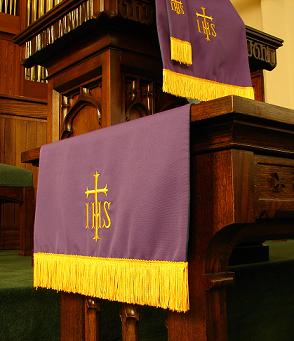ASH WEDNESDAY:
THE "FRIDAY" IN MID-WEEK
As previously mentioned, Lent is a season which begins forty-six days before Easter day (forty weekdays of fasting plus six Lord’s Days). And, because Easter day always occurs on a Sunday, Lent always begins on a Wednesday—known as Ash Wednesday.
Ash Wednesday gets its name from the practice of placing ashes on the foreheads of Christians as a sign of repentance. The ashes used are gathered after the palm fronds from the previous year's Palm Sunday are burned.
Ash Wednesday reflects the solemnity of the Friday of Christ’s death. But, in some ways, the solemnity of Ash Wednesday exceeds that of Christ’s death. The crux of the rites of Ash Wednesday is in the formula spoken at the imposition of ashes: “Remember, O mortal, that you are dust; and to dust you shall return" (Genesis 3:19).
Ash Wednesday is intended to be a bold confrontation with death. This is to many in our world a painful dose of reality—we live in a culture which prefers to ignore death. But, the church declares brashly once a year: “You will die! You are powerless to prevent it! Denial will get you nowhere! The death rate is exactly what it has always been—one per person!”
Ash Wednesday is intended to set in motion a reconsideration of the meaning of life and death—apart from Christ and in Christ. Ashes (the sign of death) are put on the forehead not in some random pattern but in the shape of a cross. By so doing, the church declares honestly, yet pastorally: “You will die! You cannot change that! But, you can die in Christ, whose death transforms your own demise. Meanwhile, live in Christ and discover Christ’s new life, which conquers death.” Thus, Ash Wednesday is the inauguration of a season (Lent) which makes Christ’s Friday our Friday.
Because Ash Wednesday begins the season of Lent, the liturgical color for Ash Wednesday is purple. Purple represents penitence because it signifies the feeling of sorrow for our sins in the light of Christ's passion and death. Purple symbolizes suffering, and therefore, mourning and penitence. It is indeed proper and fitting for us to mark Ash Wednesday with the holy color of purple.
RETURN TO DAYS & SEASONS (When We Worship)


 Copyright © 2011-2014 First Presbyterian Church, Richmond, KY. All rights reserved.
Copyright © 2011-2014 First Presbyterian Church, Richmond, KY. All rights reserved.